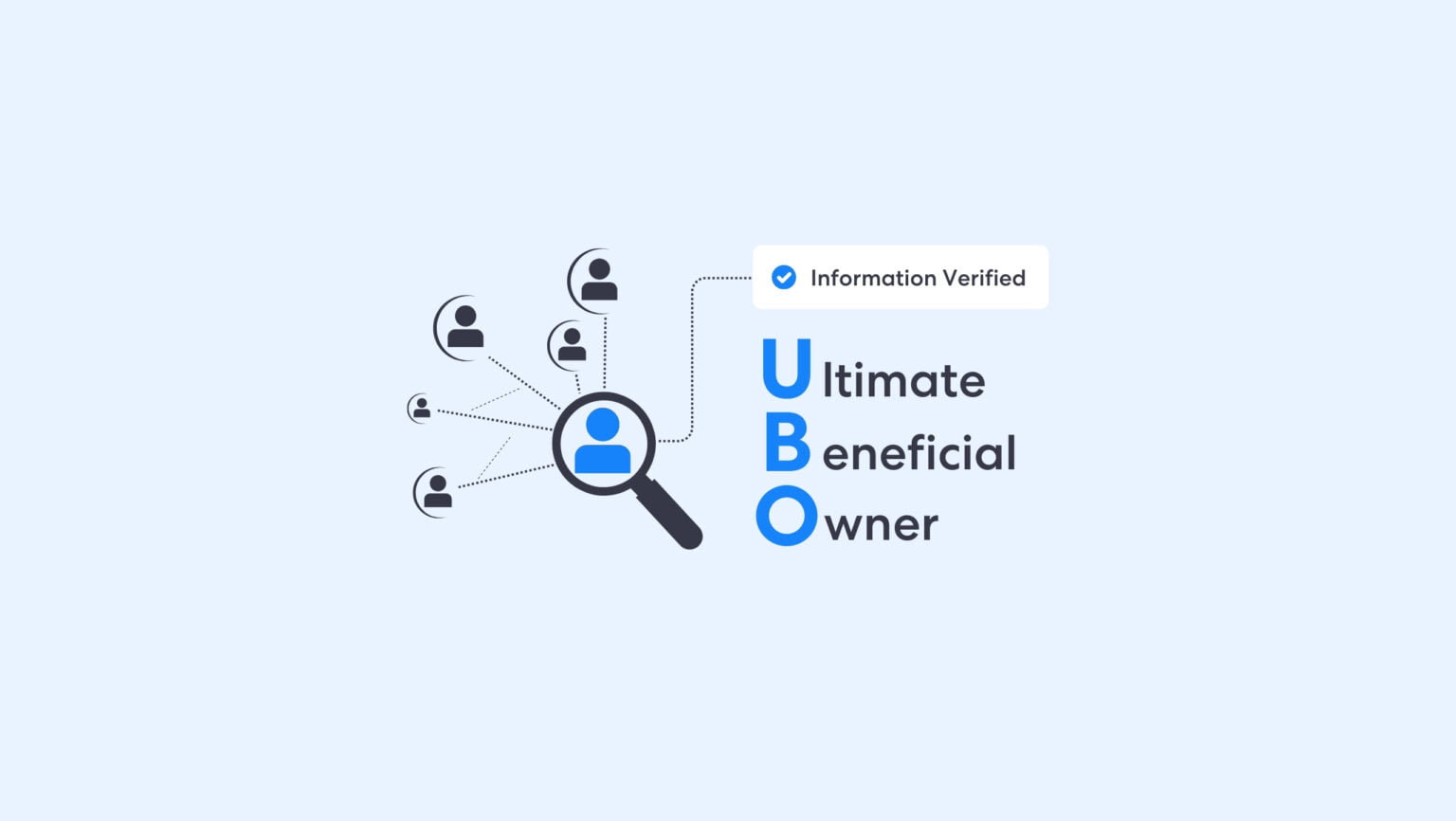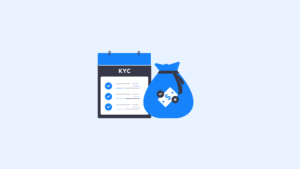Stabilire l'Ultimate Beneficial Ownership (UBO) di un'entità può essere molto impegnativo e richiede tecnologie Know Your Business (KYB) per aiutare a consentire la conformità. Il significato comune di UBO è l'individuo o il gruppo che ha il controllo ed è responsabile delle azioni intraprese da un'altra entità.
Questa guida illustra cos'è un UBO, come vengono utilizzati alcuni metodi comuni per nascondere la proprietà effettiva e perché può essere così difficile identificare il vero controllore di un istituto.
Cos'è il beneficiario effettivo?
Un UBO è la persona fisica o il gruppo di persone che possiede e/o controlla un'altra entità. Le entità possono variare da un altro essere umano a un istituto multimiliardario. Mentre il beneficiario effettivo potrebbe controllare una parte significativa della responsabilità, potrebbe non essere elencato direttamente nei documenti ufficiali di un'azienda o nei registri di un individuo affiliato.
La definizione standard di Ultimate Beneficial Ownership è quando 25% (o più) sono controllati da un gruppo o individuo. Una quota così grande garantisce al/ai proprietario/i livelli senza pari per esercitare il controllo finale ed effettivo.
Cos'è l'UBO di una società?
Il beneficiario effettivo di una società è la persona o il gruppo che in ultima analisi trae beneficio dalle attività dell'azienda. Ciò significa che ha il potere di prendere decisioni significative in merito alle operazioni, alle finanze e alla direzione strategica della società.
Identificare l'UBO è fondamentale per le istituzioni che stabiliscono nuove relazioni commerciali. Devono garantire che gli operatori di una società partner siano conformi e operino legalmente. Non farlo potrebbe portare alla non conformità con gli obblighi finanziari e Antiriciclaggio (normative antiriciclaggio) o altre sanzioni aziendali.
Cos'è il beneficiario effettivo di una persona fisica?
La proprietà effettiva di un individuo si riferisce a qualcuno che trae vantaggio da beni detenuti da un'altra persona o entità. Questi casi spesso includono individui i cui beni sono detenuti in fondi fiduciari o tramite accordi di custodia. In questi casi, l'UBO ha il diritto legittimo di ottenere profitti o altri benefici economici da essi, ma il trustee detiene la proprietà legale dei beni.
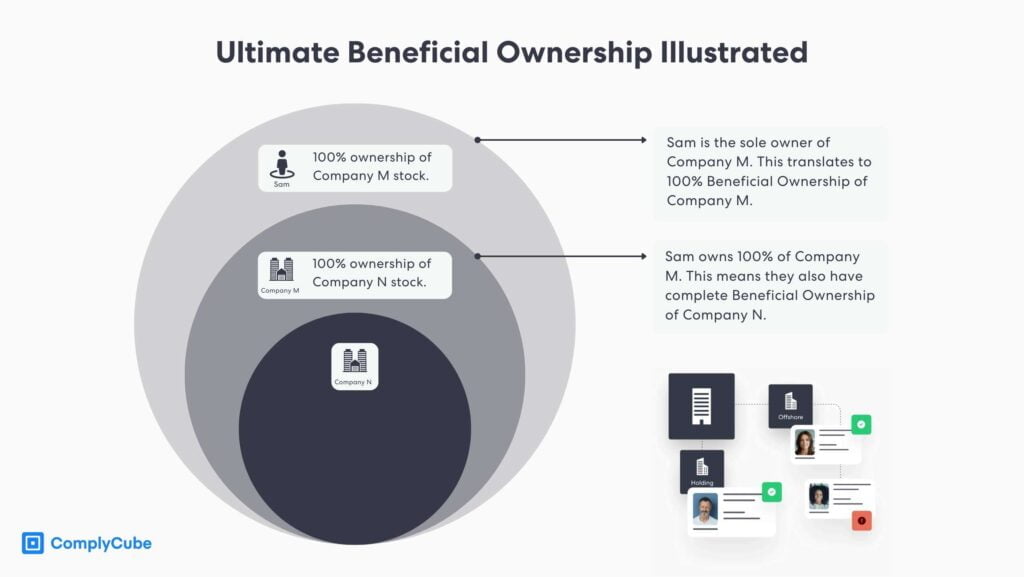
Che cosa significa Conosci la tua attività?
Conosci il tuo business è il processo utilizzato dalle istituzioni per identificare i background delle aziende con cui potrebbero lavorare. Ciò include l'accertamento della struttura proprietaria (Ultimate Beneficial Ownership), della salute finanziaria e legale e della conformità a leggi come le normative AML.
Le soluzioni KYB sfruttano tecnologie avanzate per semplificare questo processo in pochi minuti, riducendo il tempo dedicato alla due diligence e i costi di inserimento di nuove aziende, oltre a consentire la conformità a normative dinamiche e potenzialmente complesse.
Il Corporate Transparency Act (CTA) negli Stati Uniti
La legge sulla trasparenza aziendale, lanciato nel 2021 ma entrerà in vigore solo il 1 gennaio 2024, richiede alle aziende di presentare informazioni specifiche sui beneficiari effettivi:noti come Rapporti informativi sulla titolarità effettiva (BOI Reports). Queste informazioni devono essere inviate al Financial Crimes Enforcement Network (FinCEN) come parte dell'AML Act americano del 2020 e la sua rinnovata missione volta ad aumentare la trasparenza aziendale e strutturale.
I dati che una società segnalante deve presentare:
- Nome legale completo e nome commerciale
- Indirizzo aggiornato del luogo in cui l'azienda svolge la propria attività/dove l'impresa svolge la propria attività
- Giurisdizione in cui è registrata la società
- Numero di identificazione del contribuente (TIN) dell'Inland Revenue Service (IRS)
I dati che ogni società richiedente e il beneficiario effettivo devono presentare:
- Nome legale completo
- Data di nascita
- Indirizzo di residenza aggiornato
- Numero di identificazione personale e documento di identità
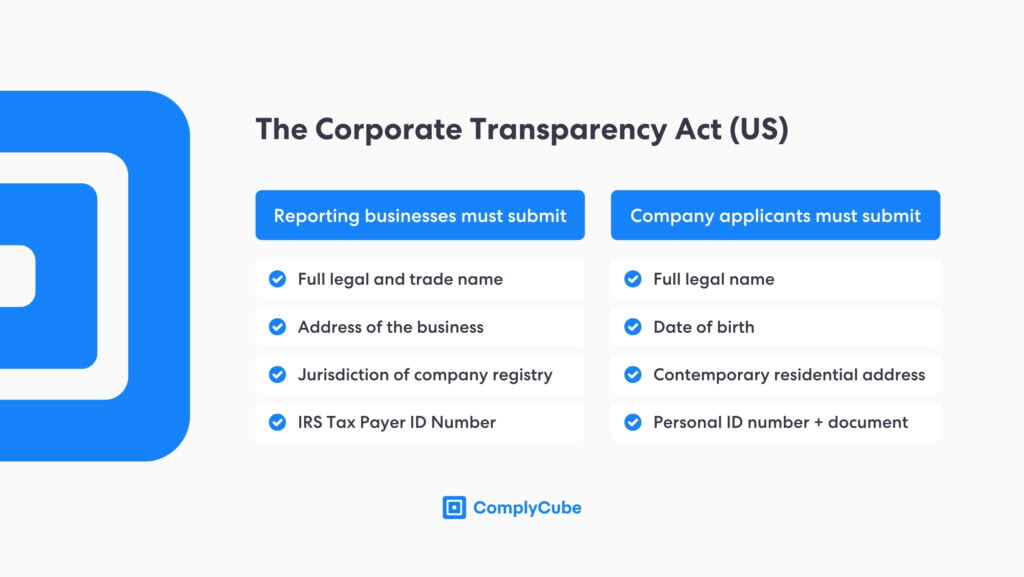
Sfide nel trovare il beneficiario effettivo finale
Le aziende affrontano molte sfide quando stabiliscono l'UBO di un'entità, di un'istituzione o di un individuo. Tra queste rientrano strutture di proprietà stratificate, opacità dei dati e discrepanze normative.
Strutture proprietarie complesse
Una delle sfide più significative nell'identificazione del beneficiario effettivo (UBO) di un individuo è la navigazione di complesse strutture di proprietà. Molti individui e alcune istituzioni strutturano la proprietà dei loro asset o della loro azienda in accordi a più livelli, utilizzando holding, trust o entità offshore per oscurare la vera proprietà di asset o capitale.
Queste strutture possono creare una rete irregolare di proprietà che rende difficile risalire al proprietario finale. L'uso di intermediari o prestanome complica ulteriormente questo processo, poiché il titolo legale potrebbe non riflettere il vero proprietario dei beni. Le istituzioni devono talvolta andare molto più in profondità della proprietà superficiale per determinare il vero beneficiario.
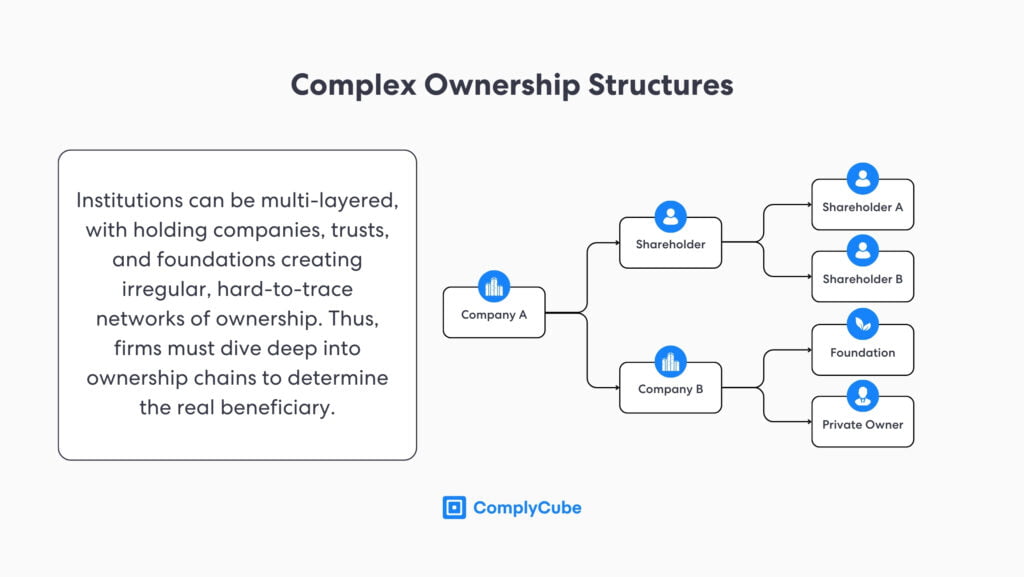
Mancanza di trasparenza
Molte regioni hanno rigide leggi sulla privacy che proteggono l'identità dei beneficiari effettivi per legge, rendendo estremamente difficile ottenere le informazioni richieste. In genere, la mancanza di trasparenza sulla proprietà effettiva si verifica nei paradisi fiscali o nelle giurisdizioni segrete che offrono un elevato livello di riservatezza, il che può proteggere l'identità degli individui che cercano di nascondere la loro proprietà.
Queste leggi protettive, sebbene giustificate legalmente, spesso ostacolano intenzionalmente gli sforzi per rivelare i veri beneficiari delle strutture finanziarie e aziendali. Ciò pone una sfida significativa per i regolatori che desiderano prevenire i reati finanziari e per le istituzioni finanziarie, tra le altre attività, che cercano partnership sicure.
Regolamenti incoerenti
L'incoerenza giurisdizionale nella regolamentazione può rivelarsi un altro ostacolo arduo per le aziende. La mancanza di uno standard globale per identificare i titolari effettivi finali delle entità legali consente a diversi paesi di definire la titolarità effettiva in modo diverso. Regolamentazioni frammentate portano a metodi disparati di identificazione degli UBO.
Questa divergenza nella regolamentazione implica che le aziende potrebbero dover utilizzare metodi di identificazione diversi nelle diverse regioni in cui operano, con conseguenti costi di conformità elevati per agevolare i diversi metodi di verifica dell'UBO.
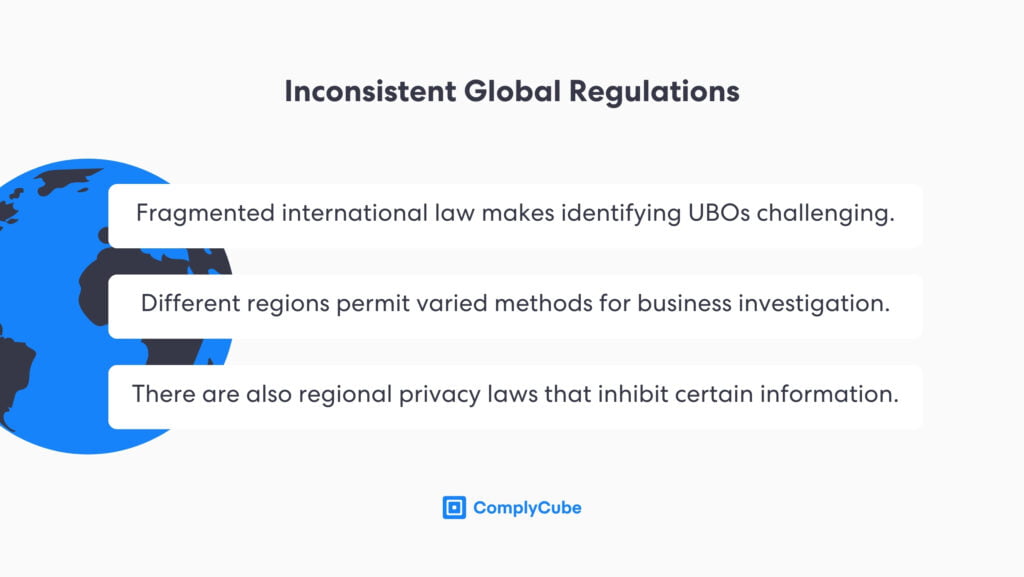
Utilizzo di Trust e Fondazioni
Trust e fondazioni possono separare la proprietà legale e effettiva, aggiungendo complessità all'identificazione degli UBO. I trustee detengono i diritti legali sui beni in questione, ma i beneficiari godono dei premi.
Identificare l'UBO può essere difficile per vari motivi, tra cui la discrezione del fiduciario, gli accordi di riservatezza e i diritti dinamici sugli asset. Le fondazioni oscurano la proprietà del fondo separando il controllo e i benefici degli asset sottostanti.
Occultamento deliberato
Individui o aziende malintenzionati che violano consapevolmente le leggi AML potrebbero scegliere di nascondere intenzionalmente la vera natura e proprietà di un istituto. Società fantasma, strumenti finanziari sofisticati o azionisti nominati sono tutti metodi validi per nascondere deliberatamente la vera proprietà di grandi entità.
Queste tattiche evasive sono progettate per oscurare la vera proprietà e il valore della quota di proprietà, rendendo difficile per le autorità o altre aziende identificare il Beneficiario effettivo finale. Le attività fraudolente, come l'uso di false informazioni per mascherare i veri proprietari, aumentano la complessità della vera identificazione degli UBO. Per combattere queste sfide, insieme alle altre elencate sopra, sono necessari solidi processi AML e KYC.
Tecnologia e risorse
L'identificazione degli UBO è, quindi, un esercizio che richiede risorse intensive e tecnologie sofisticate per essere completato in modo efficiente e conveniente. Le aziende più piccole con risorse limitate potrebbero avere difficoltà a implementare sistemi robusti per tracciare e verificare gli UBO. Le barriere tecnologiche, come sistemi IT obsoleti o incompatibili, possono ostacolare la condivisione e l'elaborazione efficienti dei dati sulla proprietà effettiva.
Il FATF raccomanda alle aziende di investire in tecnologie moderne e risorse correlate per superare queste sfide. Ciò consentirà alle aziende e agli enti normativi di semplificare i processi, migliorare l'accuratezza dei dati e garantire la conformità ai requisiti di trasparenza.
Nel suo Raccomandazione aggiornata 24, la Financial Action Task Force (FATF) fornisce linee guida su come le aziende dovrebbero identificare gli UBO a livello unificato e globale. Inoltre, il Regno Unito ha rilasciato il suo Legge sui reati economici e sulla trasparenza aziendale nel 2023/24, rafforzando l'autorità della Companies House e stabilendo un nuovo standard globale. L'Atto dimostra l'ambizione del Regno Unito di fornire le risorse e creare un ambiente per reprimere il riciclaggio di denaro.
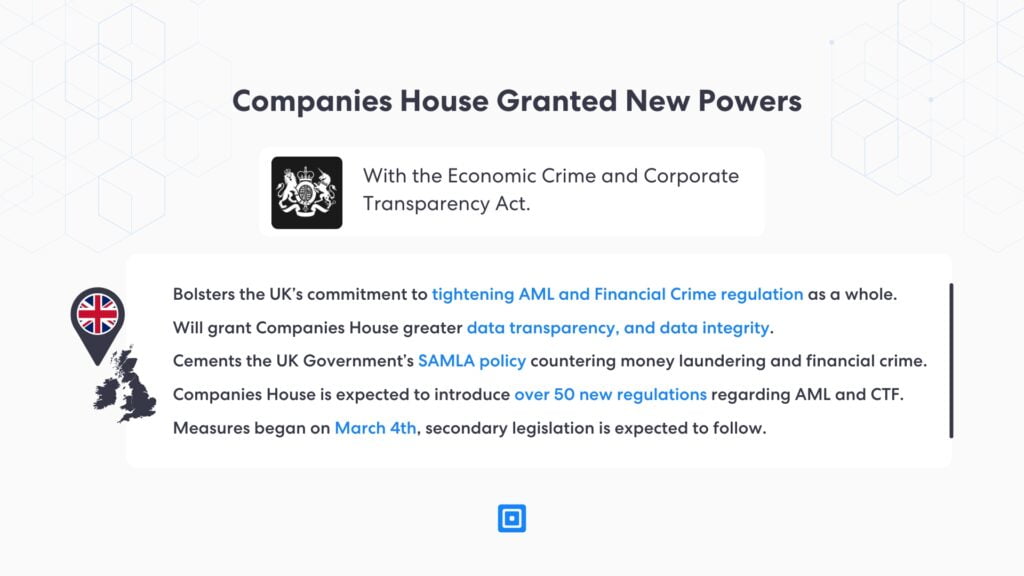
Il ruolo di Know Your Business Solutions
Le soluzioni KYB svolgono un ruolo cruciale nello stabilire e mantenere la conformità alle normative internazionali, come l'identificazione dell'Ultimate Beneficial Ownership. Know Your Business è progettato per aiutare le aziende a destreggiarsi tra le complessità dell'identificazione e della verifica dei beneficiari effettivi dei loro partner, clienti e altre entità con cui interagiscono.
Sfruttando le tecnologie KYB, come ComplyCube, le aziende possono semplificare notevolmente i loro processi di due diligence, ridurre i rischi associati ai reati finanziari e al riciclaggio di denaro e garantire il rispetto delle normative antiriciclaggio locali e internazionali.
È tempo di adottare la tecnologia di conformità
L'integrazione di tecnologie sofisticate, come l'intelligenza artificiale (AI) e il machine learning (ML), è fondamentale per fornire un rapido processo di identificazione. Quando questo è abbinato a un'interfaccia utente (UI) e un'esperienza utente (UX) eleganti, i processi di conformità vengono notevolmente semplificati sia in termini di tempo che di costi spesi per la due diligence.
Soluzione KYB di ComplyCube
ComplyCube è un fornitore di servizi Know Your Customer (KYC) e KYB leader di mercato. I suoi servizi sono utilizzati attivamente in tutto il mondo per orientarsi nelle complesse strutture legali e aziendali utilizzate dalle aziende per offuscare identità e proprietà reale.
La società globale di conformità AML stabilisce nuovi precedenti in termini di tempo di integrazione. Con una soluzione no-code, low-code, hosted o con integrazione completa, le società partner hanno la possibilità di iniziare a utilizzare il prodotto hosted di ComplyCube in meno di un giorno o di integrare completamente le sue soluzioni AML nel loro attuale stack tecnologico di conformità.
Scopri di più sull'offerta di conformità di ComplyCube contattare oggi stesso uno specialista KYB e AML.
